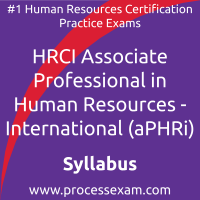 To achieve the professional designation of HRCI Associate Professional in Human Resources - International from the HRCI, candidates must clear the aPHRi Exam with the minimum cut-off score. For those who wish to pass the HRCI HR Associate Professional in Human Resources - International certification exam with good percentage, please take a look at the following reference document detailing what should be included in HRCI HR Associate Professional in Human Resources - International Exam preparation.
To achieve the professional designation of HRCI Associate Professional in Human Resources - International from the HRCI, candidates must clear the aPHRi Exam with the minimum cut-off score. For those who wish to pass the HRCI HR Associate Professional in Human Resources - International certification exam with good percentage, please take a look at the following reference document detailing what should be included in HRCI HR Associate Professional in Human Resources - International Exam preparation.
The HRCI aPHRi Exam Summary, Sample Question Bank and Practice Exam provide the basis for the real HRCI Associate Professional in Human Resources - International (aPHRi) exam. We have designed these resources to help you get ready to take HRCI Associate Professional in Human Resources - International (aPHRi) exam. If you have made the decision to become a certified professional, we suggest you take authorized training and prepare with our online premium HRCI HR Associate Professional in Human Resources - International Practice Exam to achieve the best result.
HRCI aPHRi Exam Summary:
| Exam Name | HRCI Associate Professional in Human Resources - International |
| Exam Code | aPHRi |
| Exam Fee | USD $300 |
| Application Fee | USD $100 |
| Exam Duration | 105 Minutes plus 30 Minutes administration time |
| Number of Questions | 90 |
| Passing Score | 71% |
| Format | Multiple Choice Questions |
| Books / Trainings | Training |
| Schedule Exam | Pearson VUE |
| Sample Questions | HRCI HR Associate Professional in Human Resources - International Exam Sample Questions and Answers |
| Practice Exam | HRCI Associate Professional in Human Resources - International (aPHRi) Practice Test |
HRCI HR Associate Professional in Human Resources - International Syllabus Topics:
| Topic | Details | Weights |
|---|---|---|
| HR Operations |
- Understanding the tactical and operational tasks related to workforce management and the HR function. Complying with the regulations and policies that affect the organization. Knowledge of:
|
33% |
| Recruitment and Selection |
- Understanding the hiring process including regulatory requirements, sourcing of applicants, formal interview and selection process, and onboarding of a new hire. Knowledge of:
|
22% |
| Compensation and Benefits |
- Understanding concepts related to total rewards such as pay and benefit programs. Responding to employee questions and handling claims in compliance with applicable laws, regulations, and company policies. Knowledge of:
|
15% |
| Human Resource Development and Retention |
- Understanding the techniques and methods for delivering training programs and developing individual employees. Knowledge of:
|
10% |
| Employee Relations, Health, and Safety |
- Understanding the methods organizations use to monitor and address morale, performance, and retention. Balancing the operational needs of the organization with the well-being of the individual employee. Understanding the laws, regulations, and policies that promote a safe work environment. Use risk mitigation procedures to protect against workplace hazards. Knowledge of:
|
20% |
Both HRCI and veterans who’ve earned multiple certifications maintain that the best preparation for a HRCI aPHRi Knowledge Certification exam is practical experience, hands-on training and practice exam. This is the most effective way to gain in-depth understanding of HRCI HR Associate Professional in Human Resources - International concepts. When you understand techniques, it helps you retain HRCI HR Associate Professional in Human Resources - International knowledge and recall that when needed.
